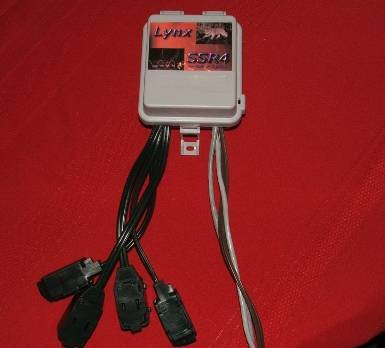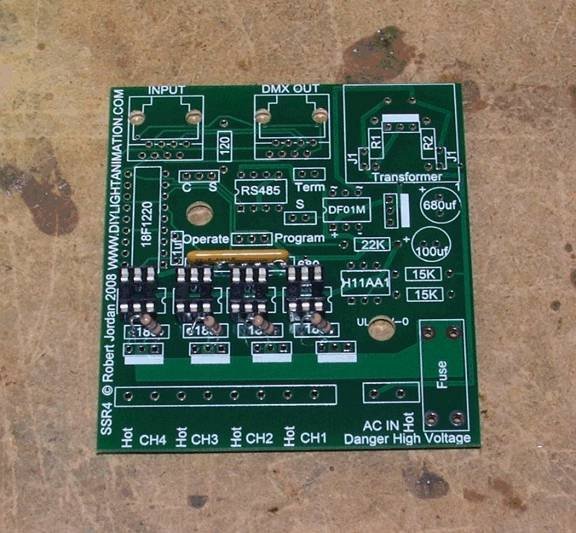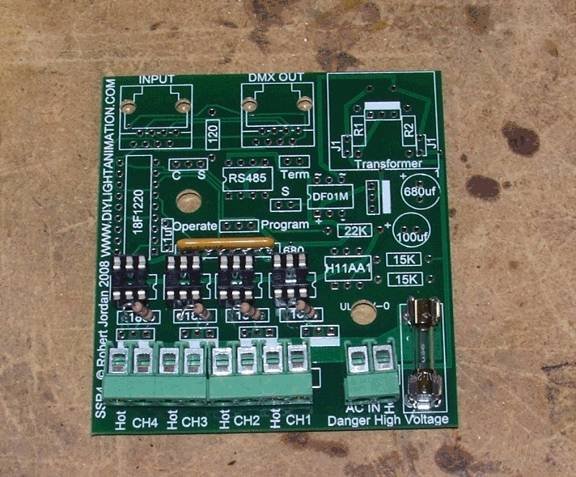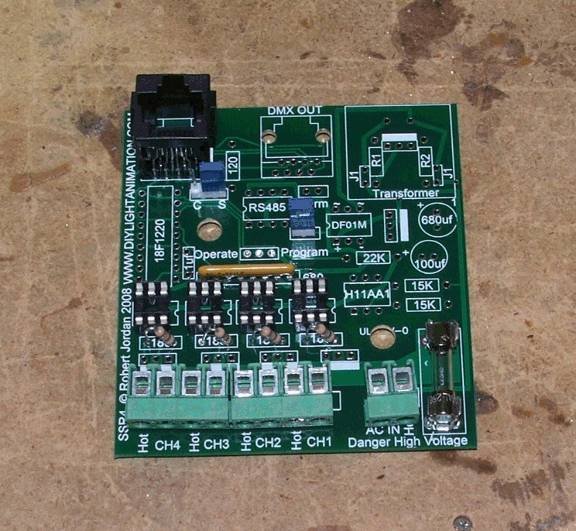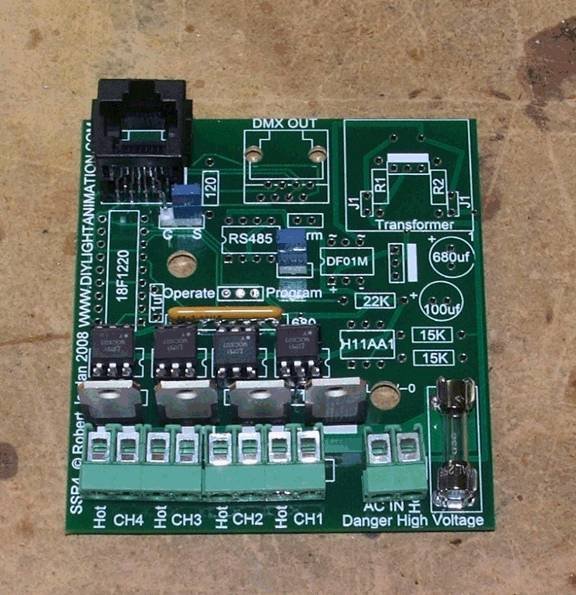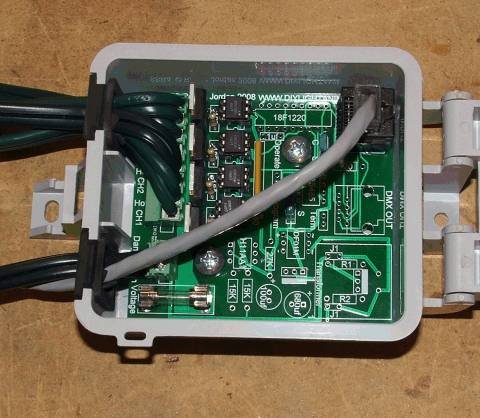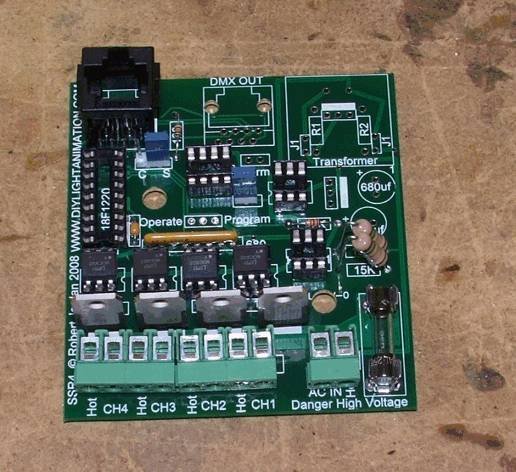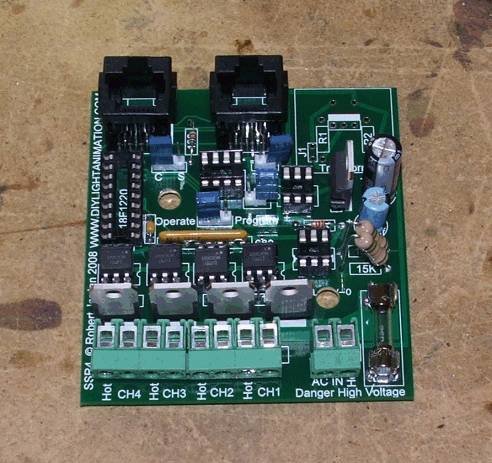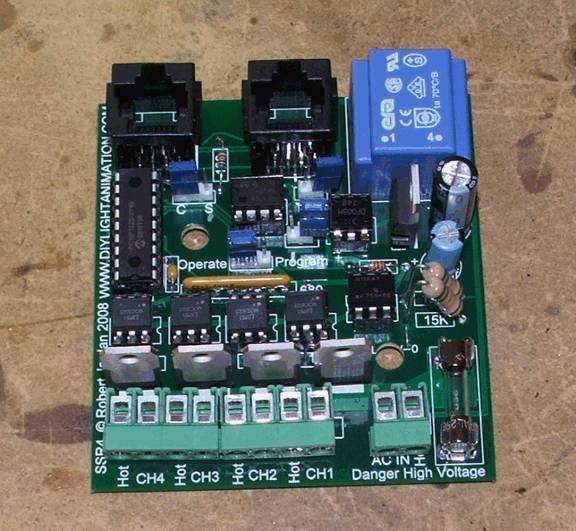Manual SSR4
Contents
Introduction
Thank you for making the decision to build the Lynx SSR4 Controller. I believe this decision will be one you will be very happy with. This controller was my attempt to design the nicest SSR that can also be a 4 channel DMX controller available for the do it yourselfer’s like you. The goals for the controller were professional looks and operation, cost effective, easy to assemble for even a novice builder, DMX compatible, software start channel programming.
The parts list and assembly instructions are for 120VAC operation. For non-120VAC use, see Appendix A below.
WARNING! This device uses potentially deadly voltages in operation. If you do not feel it is within your ability to work with these voltages please stop and get assistance, or purchase ready built commercial dimmers. This dimmer has been design for personal use as a means of education and entertainment. As such it is not rated, tested, or approved for use in commercial environments and as such is forbidden by the designer. Improper use of this equipment could be hazardous to life and property and the suitability of use is your responsibility. I assume no responsibility in the use or operation of this equipment or for the accuracy of any information made on part of itself. This device has been design for my use and my use only. This is simply an explanation of how I built my own personal dimmers for informational purposes. I make no warranties written or otherwise to it. It should be considered an experimental device with possible unknown characteristics.
Please use static precautions in the handling of these parts. If you are not familiar in them please research on the internet prior to handling them. You can damage you parts with improper handling!
Preparing to Build
The next thing we want is to make sure you are up to speed on soldering and electrostatic protection of the components in your kit. If you are not an experienced printed circuit builder I recommend you visit the site:
http://curiousinventor.com/guides/How_To_Solder
And check out there extremely good video on soldering correctly. Even if you are an expert it is a good video to watch.
Another issue you must be aware of is that some electronic components can be damaged easily by electrostatic charges that can build up in you or your equipment. We have all been shocked by walking on carpet and grabbing a door knob before. This is electrostatic charge in action. It takes much less than this to hurt some of our parts. If you are unfamiliar with procedures to protect from this please use the internet to research it before opening your parts up. You can damage your parts if handled wrong!
You will need a few tools that do not come with your kit to build the SSR4. You will need a good soldering iron. I can not stress enough that a good soldering iron makes a big difference in these projects. The little 15w cheap irons are more apt to hurt your parts by taking too long to get the parts up to soldering temperature than a good iron which can bring it up to temp very fast. Remember it is more how long you keep the part hot than it is how hot you get it within reasonable soldering temperatures. A good soldering iron can be had for very reasonable amounts of money. You can purchase one for $30 to $60 dollars. Most anything that is called a soldering station where there is a temperature control separate from the iron itself will more than likely be fine but make sure it is rated for more than 15 watts. I myself use a cheap Weller like this one
http://www.amazon.com/Weller-Soldering-Station-WLC100-120V/dp/B000ICEMYA
It works fine and is very inexpensive. I even saw this model on sale at Sears. Radio shack has a very nice looking digital model on sale but be careful as it does not allow you to replace the tip. Tips are a part that wear out and need replacing from time to time. While we are on tips get some. I recommend you get the smaller chisel shape as this work very well for all around board building.
You need solder so buy some. I recommend the .032 size as the larger sizes tend to cause you to put too much solder on. How much? Go ahead and get a 1 lb spool as it’s cheaper in large volume and you will go through it faster than you think. Make sure you are getting rosin core for electronics they make some solder for plumbing that has acid as the core this is a bad mistake to make.
You need some work area to work with good lighting. Do not attempt to solder circuit boards in poorly lighted areas. If you wear reading glasses go get them you will want them I promise you. I recommend a set of helping hands like this: http://www.radioshack.com/product/index.jsp?productId=2104639&cp=&parentPage=search
Step 1
Install all chip sockets and the resistors
SSR4 board after the sockets and resistors were installed
Ok we are ready to start assembly of the SSR4. We will first build it as a SSR only and then add the additional parts kit to make it a full blown DMX controller. Doing so may well not be the best way to build on that you are doing as a DMX controller but it will allow us to get everyone to that point and then those building it as a controller will continue on. Once you have built one you will find your own preferred method and order of assembly it really only matters that everything gets installed and the parts that it matter on are point the correct way.
Begin by opening and removing all of the chip sockets (DIP SOCKETS) from the SSR parts bag. There should be 4 six pin sockets. Now all of the components have marking on the top side of the PCB board to show their location but you must pay attention to their orientation so they have the correct pins in the correct place. The socket locations all have rectangles with little round notches on one end of them with the other end being flat. The notched end is the end that pin #1 of the chip will go to. On the circuit board you will find the area marked out for the 6 pin socket and they will be labeled 3023. The marking will have one end with a round notch on it. The notches on all the sockets do not face the same way so please pay attention to this. When I reference left or right top or bottom in these instructions it will be as the board sits in the photo.
All soldering takes place on the bottom or (back) of the board away from the markings. Remember that when you turn the board over to the back every thing reverses on you.
Everyone has they own way of holding the socket in until they are soldered in. I like to turn the board over to the back and put the least amount of solder I can over one of the middle holes on one side of the socket. This allows you to put the pins of the other side of the socket through and hold the socket while pushing extremely easy. Then you heat that one hole on the back. When the solder melts the socket will drop in. remove the iron and it will cool and hold the socket in until you are done. Make sure to reheat this pin while doing the others to insure you have a good joint. Some people prefer to use tape to hold them in and some even super glue them on first and then solder. Some place all of them in and place a second board over them and flip this using the top board to hold them in while you place it on you bench. Make sure your socket is in the correct holes and that it faces the correct way and then solder the other pins in. If you are happy with it you can go ahead and start soldering the other sockets in.. And check each one for direction before soldering it.
Now once the sockets are all in let’s find the resistors and get them put in. The resistor that is a SIP (Single Inline Package) goes in the 8 holes marked 680 and the direction on this sip does not matter. Place it in and solder it on the board.
The four 180 ohm resistors go into the four rectangles below the 3023 sockets marked 180. You will stand them up as in the picture. This was needed because of space limitations.
That’s a lot of soldering so take a break. If you try to do too much in one sitting you will start making too many mistakes and mistakes with solder are costly in time. Notice that we started with fairly short items. It is best to put short items on and work out to the taller items as you go. As you progress you will understand better why this is. The image at the top of this section is what it should look like at this point.
Step 2
SSR4 after step 2
Now let’s find the fuse and the two fuse holders. Snap the fuse into the two holders making sure they have the end limits turned the correct way. The end limiters are the bent in part of the fuse holders the keep the fuse from sliding back and forth and should be up tight to the end of the fuse. Now put it into place and solder. You will want to turn the heat on you iron up a god bit to solder this as it will be a big heat sink.
Find the two 4 position and the 1 two position screw terminals and install the as shown. Make sure the screw heads face down to the bottom of the board.
Step 3
Find the three terminal and the two terminal jumper headers and solder them in the locations shown. Make sure you are putting the three terminal on the C/S position and the two terminal on the (S) Location. The Term and the Operate/Program positions are for later when we make this a Controller.
Find your RJ45 jack and pop it into place on the location marked for it that has input above it. Now solder it into place.
Final Assembly For the SSR only
Put the four triacs (pn# 511-BTA06-600S) in their place with the metal side facing down toward the connectors as in the picture. Solder them in place. It helps to cut some of the excess lead length off of them after you insert them. Then turn you iron up some as they take some heat to solder well. If you are on a lead for more than 10 seconds and the solder is not flowing get off of it and let it cool down. Then turn your iron up some more. It is less about the temp of the iron and more about the time on the part. If you are too cold and so you spend too long on the part this is when you will burn them up. It is better to be a little to hot and be on the part for a short amount of time.
Now we need to insert the chips into their sockets. Get them oriented correctly with pin one in the correct position. Pin one is marked on the chips as a notch on the end where pin 1 is and sometimes a dot over pin one. Make sure you put chips in very careful and do not bend any pins as they sometimes can be a challenge to insert straight. Take your time here and before pushing them in look over both side to make sure all pins are started straight. TAKE YOUR TIME HERE!
Now using ½ “long screws screw your SSR into the case. And make sure the jumpers are in the location on the picture.
Do not attempt to control more than 1 amp per channel from the SSR4 controller without a heat sink added. You can add a piece of aluminum angle to them and run 2 amps per channel max.
At this point if you are not adding the DMX option to your SSR4 then stop and add the extension cords for the outlets, and a plug for the input of 120 volts as shown below.
Adding the optional DMX to the SSR4
Step 1
Open your bag of DMX parts and find the chip sockets. You should have no problem finding the location for these on the board so make sure to put them in the correct direction and solder them in.
Now find the 120 ohm resistor and locate it place between the locations for the two RJ45 jacks and install it.
Find the 22K resistor and install it in its place between the two 6 pin sockets.
Install the two large 15K resistors in their place above the fuse. You will stand these up as in the picture. Make sure they do not touch anything else as they carry 120 volts when live.
Install the one .1 uf cap next to the large socket.
Step 2
Install the two capacitors (680uf & 100uf) just above the large 15K resistors.
Install the 7805 5 volt regulator (pn# 511-L7805ABV) to the right of them with the metal side facing the capacitors.
Install the 2 terminal pin jumper in the location marked TERM. And the 3 terminal pin jumper in the location marked operate/program.
Install the second RJ45 jack in its location.
Step 3
Install the Transformer on the board. It will only fit one way and you can ignore the markings under it as they are for optional parts for non 120 volt operation.
Now we need to put the chips in. As before take your time. There are two 6 pin chips make sure the one with the + - on the top of it is put near the Transformer and the + - side is lined up with the + - markings on the pcb.
Make sure these chips are inserted in the correct direction. Now set you jumpers as shown above to make it a Controller.
Programming and Operation of the SSR4
The SSR4 jumpers are setup like this:
- The C/S (Controller / SSR ); for Controller set it to C and for SSR set it to S.
- The (S) jumper is needed to be on for SSR operation and off for Controller operation.
- The Operate/Program jumper is the same as on my other systems. You set it to operate to use it and program to program it.
- The Term jumper is to terminate the DMX line if this is the last device on the line.
The SSR4 controller first needs to be programmed for its starting channel. This is the channel that #1 output cable will be addressed by in the DMX data. If you want this controller to handle channels 80 – 83 (4 channels) you would assign it the starting channel of 80.
To program the Lynx Controller/Dimmer.
- Note: For MR16/DC Controller, where it says turn power on or off, substitute that for connect/remove the negative power lead to/from the MR16
- Note2: Dongle DMX & Pixelnet Firmware - Require different software in order to set the start address
- Note2: DMX Firmware you can use RJ's Lynx Address Program or DMX Deck
- Note2: Pixelnet Firmware you can use Start Channel or xLights or your Sequence software with Pixelnet
Step 1 - Turn off power to controller and move jumper to program mode Leave Power OFF until Step 3
Step 2 - Use appropriate software (see Note2 above) and select address you need. Click on Program button
Step 3 - Turn on controller and count to 5
Step 4 - Turn off controller and move jumper back to operation mode Leave Power OFF until Step 6
Step 5 - Click Stop on the Lynx Address Program
Step 6 - Turn on controller and use your selected program to see if controller is now on the correct start address.
Either exit selected Program or go back to step 1 to program another controller
OPTIONAL Way if the above doesn't work - From RJ
Step 1 - Power up Controller.
Step 2 - Using selected program start to send the address you want.
Step 3 - With power ON carefully move the jumper to Program.
Step 4 - Count to 3 seconds.
Step 5 - Turn OFF the controller.
Step 6 - Put the jumper back to operate and power up controller to try/test.
That’s it! It is set to operate on the channel you wanted. You can change it anytime and as often as you need. It will remember the address for at least 20 years with no power applied.
Being DMX the controller can be controlled from programs other than Vixen if you so choose. it should work with any DMX devices and I have tested it using a number of downloadable software from the internet including the trial edition of Light Factory that comes with the DMX PRO.
When using Vixen I recommend you set Vixen to “draw at 255 levels” instead of 0-100 levels. You want to have 0 -255 levels this will give you access to all 256 levels it provides and not limiting it to just 100 steps you can manual set.
To connect another DMX device to this one simply use a standard straight through Cat5 cable to go from the “DMX OUT” jack to the next Device and connect it to the “DMX IN” jack.
BE SAFE!
Thank you, enjoy your Controller and
MAY GOD BLESS YOU IN ALL YOU DO!
Appendix A - Alternate Voltage Modification
The SSR4 can be used with a controller such as FreeStyle* to dim non-120VAC lights. The modification involves changing the four (4) 180 Ohm resistors to a value specific to the operating voltage of your light strings.
For 240VAC substitute four (4) 330 Ohm Resistors
(Mouser part number 660-CF1/4C331J 1/4Watt Axial Leaded Carbon Film Resistors 330ohm 5%)
For 36VAC substitute four (4) 47 Ohm Resistors
(Mouser part number 660-CF1/4C470J 1/4Watt Axial Leaded Carbon Film Resistors 47 OHM 5%)
For 24VAC substitute four (4) 33 Ohm Resistors
(Mouser part number 660-CF1/4C330J 1/4Watt Axial Leaded Carbon Film Resistors 33 OHM 5%)
For 12VAC substitute four (4) 22 Ohm Resistors
(Mouser part number 660-CF1/4C220J 1/4Watt Axial Leaded Carbon Film Resistors 22 OHM 5%)
Your modified SSR4 can now be powered by the appropriate AC Voltage (e.g. by a mains supply through a transformer.) To connect your light strings to the outputs of a modified SSR4, first remove any in-line transformer from the strings. Depending on the construction of your light strings, you may wish to remove any built-in controller to control discreet circuits in a light string individually. Further "how-to" information is available by searching the forums.
*Note: At this time the SSR4 DMX Option is not available for non-120VAC use.
Appendix B - Extras
You might be interested in some of these finds to finish out your SSR4 boards:
- Cases for SSR4: no link provided
- Heatsink: no link provided
